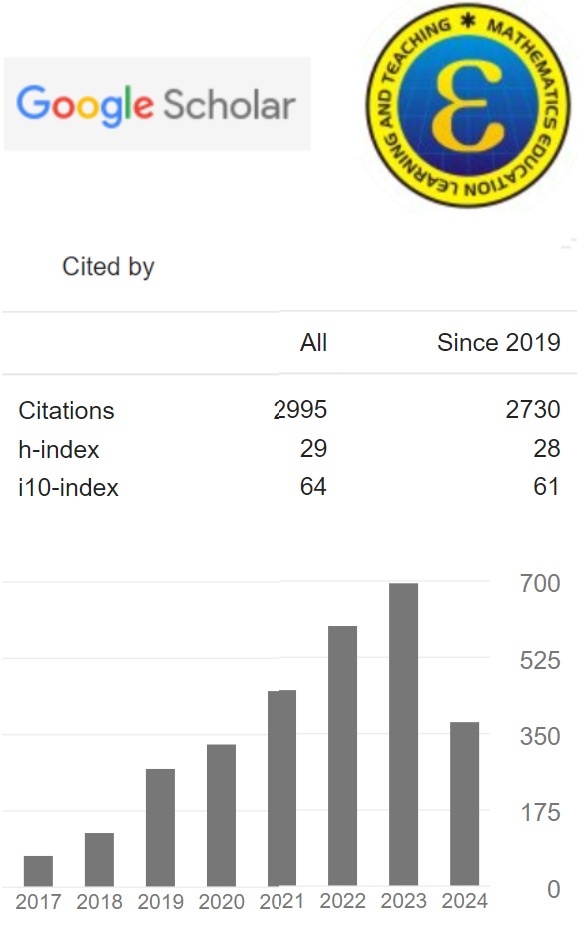Dimensions of Cognitive Processes and Dimensions of Knowledge in School Exam Questions for Junior High School Mathematics in Subrayon 05, Semarang Regency
(1) IAIN Salatiga
(2) IAIN Salatiga
(3) IAIN Salatiga
(*) Corresponding Author
Abstract
This study aims to describe the cognitive processes and knowledge dimensions that are measured on exam questions for junior high school mathematics in the Subrayon 05 Semarang Regency for the 2021/2022 academic year. This study uses a qualitative approach with content analysis techniques. Data collection is carried out through documentation. For further analysis of the contents of the data in the form of school exam questions. The research instrument includes a question review guide that is determined based on the dimensions of cognitive processes and the dimensions of knowledge. The results showed that the dimensions of cognitive processes and the dimensions of students' knowledge as measured through school exam questions for Mathematics subjects in Sub-Rayon 05 Semarang Regency ranged from understanding facts to creating which procedures; on questions that measure understanding facts, students are asked to classify facts in the form of notation, on questions that measure understanding of concepts, students are asked to classify related to certain mathematical concepts; on questions that measure applying concepts, students are asked to use or implement certain mathematical concepts in order to solve problems; on questions that measure applying procedures, students are asked to use or carry out certain mathematical procedures in order to solve problems; In questions that measure the ability to create procedures, students are asked to generate/hypothesizing specific skills and algorithms.
Keywords
Full Text:
PDFReferences
Amalia, R. (2016). Kemampuan Berpikir Matematis Mahasiswa Dalam Menyelesaikan Masalah Geometri. Edu-mat Jurnal Pendidikan Matematika, 4(2), 118–125. https://doi.org/10.20527/edumat.v4i2.2568
Anderson, L. W., & Krathwohl, D. R. (2001). A taxonomy for learning, teaching, and assessing: A revision of Bloom's taxonomy of educational objectives. Longman.
Crooks, N. M., & Alibali, M. W. (2014). Defining and measuring conceptual knowledge in mathematics. Developmental review, 34(4), 344-377. https://doi.org/10.1016/j.dr.2014.10.001
Elisa, I. (2015). Analisis Butir Soal Ujian Nasional Smp/Mts Mata Pelajaran Matematika Tahun 2013 Berdasarkan Taksonomi Bloom Dan Metode SEC. Universitas Jember.
Elviana, E. (2020). Analisis Butir Soal Evaluasi Pembelajaran PAI Menggunakan Program Anates. Jurnal MUDARRISUNA: Media Kajian Pendidikan Agama Islam, 10(2), 209-224. http://dx.doi.org/10.22373/jm.v10i2.7839
Fathonah, D., Hapsari, T., & Firmasari, S. (2021). Kemampuan Pemahaman Konsep Matematis Siswa pada Materi SPLDV Menggunakan Soal-soal Berbasis Taksonomi SOLO. Jurnal Pendidikan Matematika, 11(2), 85-91. https://doi.org/10.22437/edumatica.v11i02.12156
Giani, G., Zulkardi, Z., & Hiltrimartin, C. (2015). Analisis tingkat kognitif soal-soal buku teks matematika kelas VII berdasarkan taksonomi Bloom. Jurnal Pendidikan Matematika, 9(2), 78-98. https://doi.org/10.22342/jpm.9.2.2125.78%20-%2098
Mu'minah, H. (2020). Analisis Kemampuan Kognitif Peserta Didik:(Studi pada Lembaga Pendidikan MI al-Kautsar Yogyakarta). Journal of Islamic Education Research, 1(02), 28-38. https://doi.org/10.35719/jier.v1i02.19
Heer, R. (2012). A model of learning objectives—based on A taxonomy for learning, teaching, and assessing: a revision of Bloom’s taxonomy of educational objectives. Center for Excellence in Learning and Teaching, Iowa State University.
Hijriati, H. (2017). Tahapan perkembangan kognitif pada masa early childhood. Bunayya: Jurnal Pendidikan Anak, 1(2), 33-49. https://doi.org/10.22373/bunayya.v1i2.2034
Hurrell, D. (2021). Conceptual knowledge or procedural knowledge or conceptual knowledge and procedural knowledge: Why the conjunction is important to teachers. Australian Journal of Teacher Education (Online), 46(2), 57-71. https://doi.org/10.14221/ajte.2021v46n2.4
Kadir, A. (2015). Menyusun dan menganalisis tes hasil belajar. Al-Ta'dib: Jurnal Kajian Ilmu Kependidikan, 8(2), 70-81. http://dx.doi.org/10.31332/atdb.v8i2.411
Kusuma, M. D., Rosidin, U., Abdurrahman, A., & Suyatna, A. (2017). The Development of Higher Order Thinking Skill (Hots) Instrument Assessment In Physics Study. IOSR Journal of Research & Method in Education (IOSRJRME), 07(01). https://doi.org/10.9790/7388-0701052632
Lenz, K., Wittmann, G., & Holzäpfel, L. (2019). Aufgaben als Lerngelegenheiten für konzeptuelles und prozedurales Wissen zu Brüchen–Eine vergleichende Schulbuchanalyse. mathematica didactica, 42(2), 105-122. https://doi.org/10.1111/bjep.12333
Munaji, M., & Jupri, A. (2022). A Diagnostic Analysis of Junior High School Students’ Difficulties in Solving TIMSS Model Mathematics Test. Eduma: Mathematics Education Learning and Teaching, 11(1), 1-19. https://doi.org/10.24235/eduma.v11i1.9360
Musyaddad, A., & Suyanto, S. (2019). Evoking the four dimensions of student knowledge in ecosystem: effectiveness of real object, web, and blended learning. Biosfer: Jurnal Pendidikan Biologi, 12(2), 194-210. https://doi.org/10.21009/biosferjpb.v12n2.194-210
Preim, B., & Botha, C. (2014). Visual computing for medicine. Theory algorithms and applications. Online-Ausg. https://doi.org/10.1016/b978-0-12-415873-3.00022-5
Sarea, M. S., & Ruslan, R. (2019). Karakteristik butir soal: Teori tes klasik and respon [Characteristics of items: Classical and response test theory]. Didaktika: Jurnal Kependidikan, 13(1), 1-16. https://doi.org/10.30863/didaktika.v13i1.296
Star, J. R., & Stylianides, G. J. (2013). Procedural and conceptual knowledge: Exploring the gap between knowledge type and knowledge quality. Canadian journal of science, mathematics and technology education, 13(2), 169-181. https://doi.org/10.1080/14926156.2013.784828
Stewart, P. W., Cooper, S. S., & Moulding, L. R. (2007). Metacognitive development in professional educators. The Researcher, 21(1), 32-40. http://www.nrmera.org/wp-content/uploads/2016/02/Researcherv21n1Stewart.pdf
Sudaryono, S. (2011). Implementasi Teori Responsi Butir (Item Response Theory) Pada Penilaian Hasil Belajar Akhir di Sekolah. Jurnal Pendidikan dan Kebudayaan, 17(6), 719-732. https://doi.org/10.24832/jpnk.v17i6.62
Syafitri, M. (2020). Analisis Butir Soal Penilaian Akhir Semester I Mata Pelajaran Matematika Tahun Ajaran 2019/2020 Kelas IV SD Negeri Se-Dabin Panggung Kecamatan Tegal Timur Kota Tegal. Universitas Negeri Semarang.
Utari, R., Madya, W., & Pusdiklat, K. N. P. K. (2011). Taksonomi Bloom. Jurnal: Pusdiklat KNPK, 766(1), 1-7.
Vukić, Ä., MartinÄić-IpÅ¡ić, S., & MeÅ¡trović, A. (2020). Structural analysis of factual, conceptual, procedural, and metacognitive knowledge in a multidimensional knowledge network. Complexity, 2020, 1-17. https://doi.org/10.1155/2020/9407162
Yulianto, M. (2019). Pemetaan Soal Latihan Ujian Nasional Matematika Berdasarkan Aspek Kognitif Tahun Pelajaran 2018/2019 di Kabupaten Banyumas dan Cilacap (Doctoral dissertation, IAIN Purwokerto).
Yustiana, I. A., & Mercuriani, I. S. (2018, March). Biology Factual Knowledge at Eleventh Grade of Senior High School Students in Pacitan based on Favorite Schools. In Journal of Physics: Conference Series (Vol. 970, No. 1, p. 012029). IOP Publishing. https://doi.org/10.1088/1742-6596/970/1/012029
DOI: 10.24235/eduma.v12i1.11741
Article Metrics
Abstract view : 14 timesPDF - 1 times
Refbacks
- There are currently no refbacks.
Copyright (c) 2023


.png)










